While Genghis Khan’s massive empire and formidable warriors may be the most-known aspect of Mongolian history, the country’s previous rulers reigned millions of years ago: dinosaurs. Paleontological and geological wonders continue to be found, luring scientists and everyday adventurers to explore, wondering, what if?
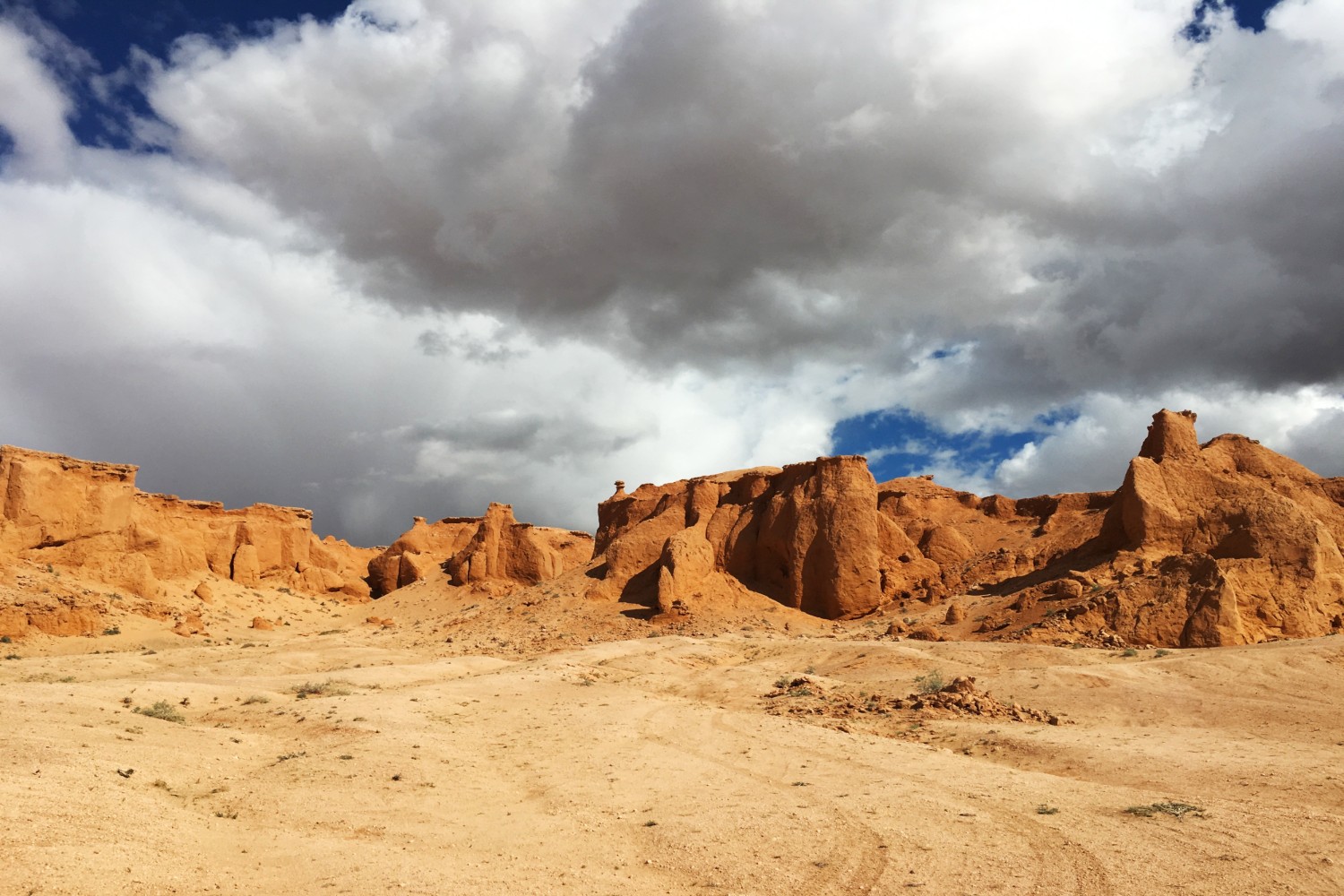
The Flaming Cliffs, known by locals as Bayanzag (Photo: Bre Power Eaton)
A sand castle-esque formation rose majestically from the Gobi Desert, disrupting the flat, barren landscape; a sudden rise of burnt-orange sandstone amidst a sea of taupe sand that stretched otherwise uninterrupted, seemingly to oblivion. The Flaming Cliffs, known by locals as Bayanzag, drew us not only for their beauty, but also their legacy of hidden treasures. A 1922 American Museum of Natural History expedition to the region, headed by the adventurous scientist Roy Chapman Andrews (the rumored inspiration for Indiana Jones) may have failed to unveil discoveries about the earliest humans, as hoped, but their search did reveal the bounty of fossils hidden in these cliffs.
One of the expedition’s landmark finds was dinosaur eggs. This first discovery of its kind (by outsiders, at least) shed light on how dinosaurs reproduced. Since, paleontological and geological discoveries have been made throughout the country, particularly well-preserved in the Gobi’s sandstone.
“Ready to hunt for dinosaur bones?” my husband Tom and I asked our toddler, Emi, who believed we had been collecting them in the form of sticks, rocks and the bones of livestock since we’d arrived in Mongolia, a week ago.
Our little explorer plopped down to play in the dirt at the base of the rock formations and began holding up circular-shaped rocks, with a texture more like hardened mud.
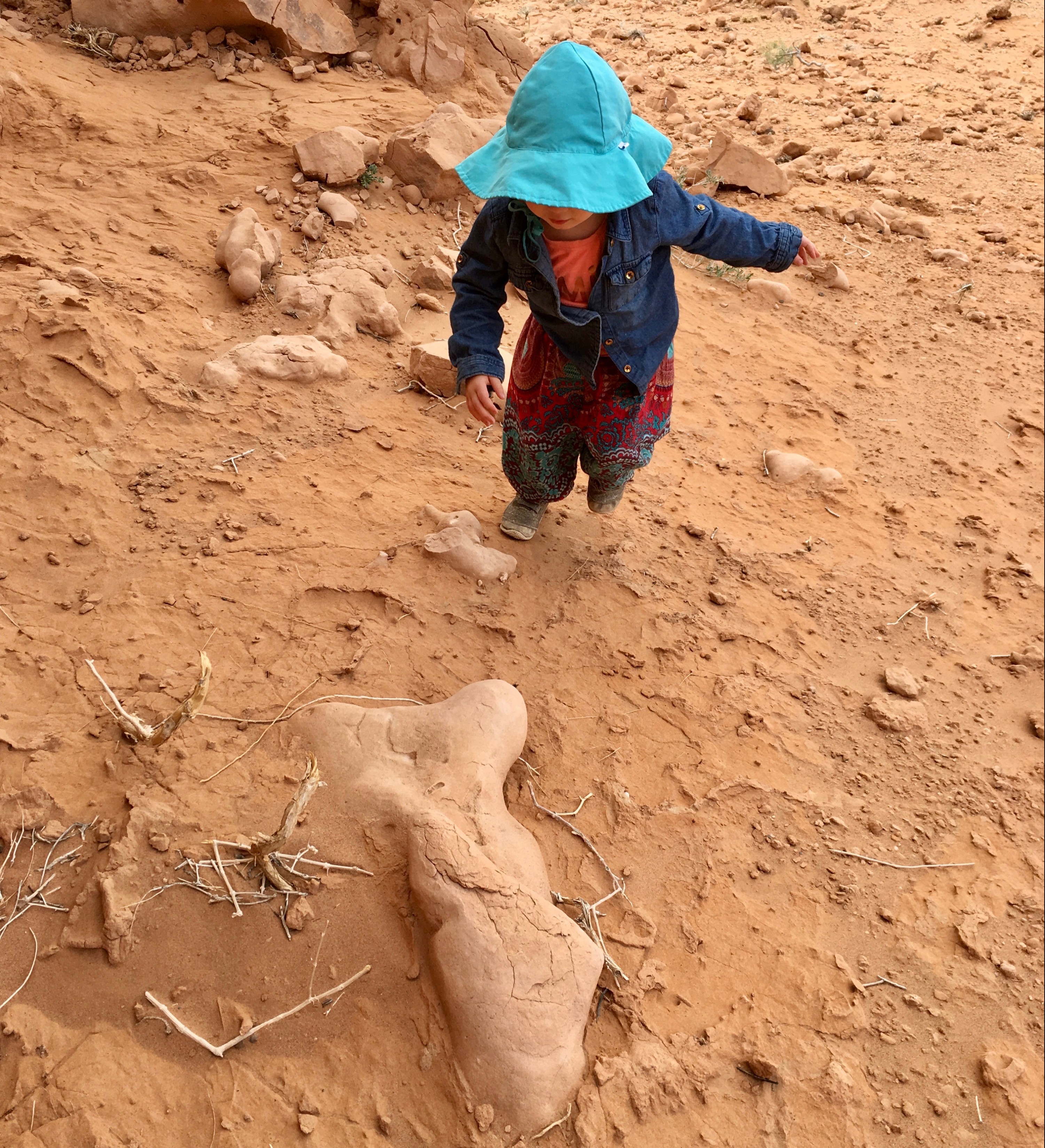
Hunting for dinosaur bones (Photo: Bre Power Eaton)
“Dinosaur eggs!” Tom and I agreed with her, echoing her excitement while exchanging winks.
The Seeds of Adventure
Our first week in Mongolia was spent traversing the uncharted steppe with our trusty guide and driver, staying with nomadic families, sleeping in guest gurs, eating traditional Mongolian barbecue and drinking earthy yak milk tea—an unforgettable mix of fascination and exhaustion. While getting a taste of nomadic life was surely a draw, our desire to take Emi to Mongolia was sparked by a dinosaur book she had brought home from school. In it, an end note mentioned a fossilized fight between a Velociraptor and a Protoceratops, trapped by a surprise sandstorm or sand-slide mid-throes, that was on display at the Natural History Museum of Mongolia. The accompanying photo was of just a menacing, fossilized claw.
“Maybe we can go see it,” I’d told Emi dreamily, knowing that our new home in South Korea meant Mongolia was only a few-hour’s flight away. The trip had seemed unlikely, exotic even, especially after we learned I was pregnant. With child and with a toddler notwithstanding, we still had a craving for adventure and wanted to feed Emi’s curiosity along with our own. If we were to ever get our fix of pretending to be paleontologists, exploring Mongolia’s rugged landscape, now was the time, before it was too late for me to fly with a blooming baby in tow.
Underneath the cliffs, Tom and I joined Emi, scouring the ground, picking up peculiarly shaped rocks reminiscent of large bones.
“Do you think these could be fossils?” we asked each other, allowing our imaginations to wander too.
I ran my hands along the rough, uneven surface of the cliffside, utterly captivated, imagining that Chapman Andrews and his crew must have done the same. My heart beat with anticipation. My eyes probed. What if that nub up ahead were the edge of a skull, a joint, a nest?
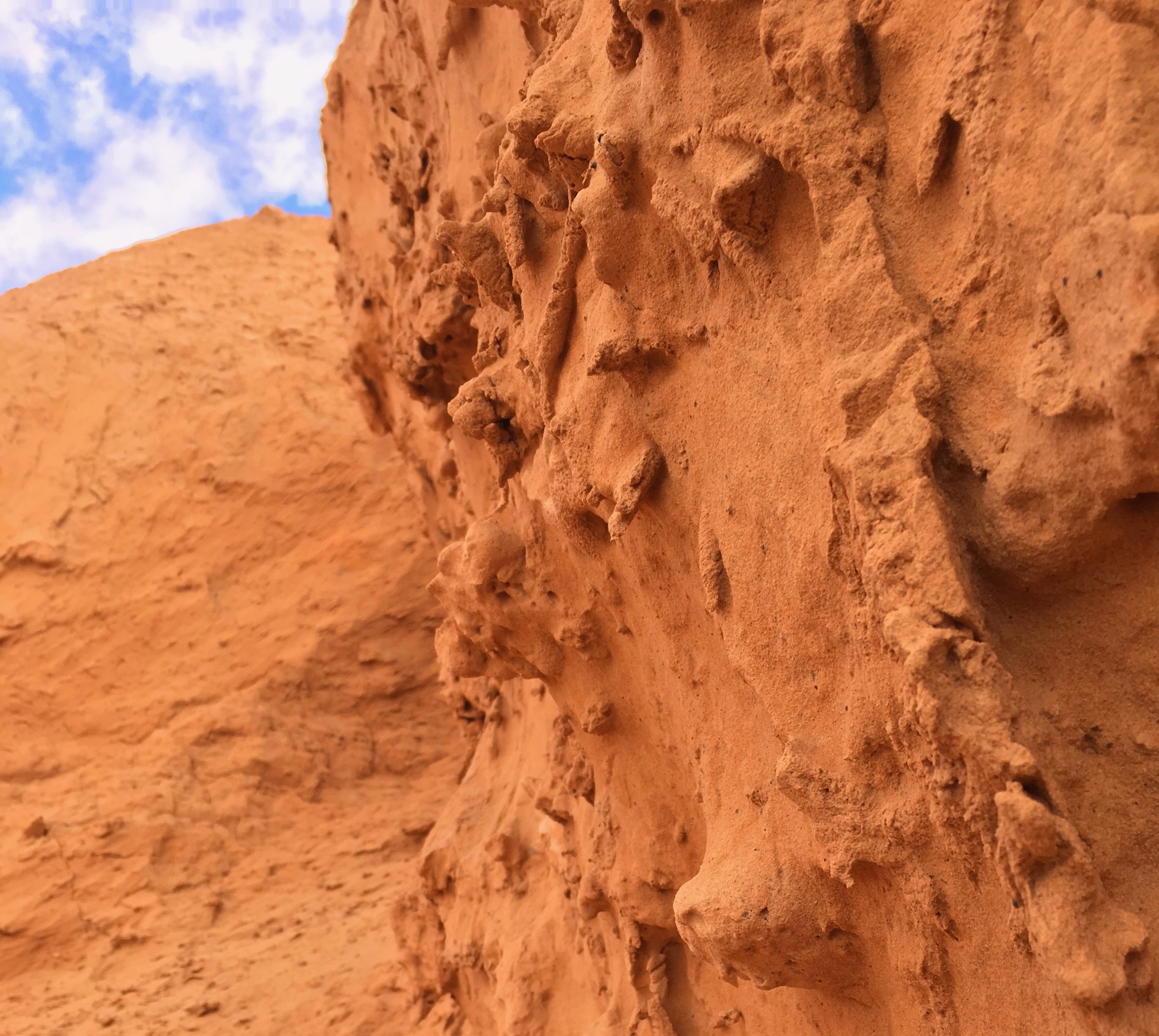
What still remains hidden in these sandstone walls? (Photo: Bre Power Eaton)
I moved slowly, savoring the feeling, like a return to childhood, when digging in my yard held the titillating suspense of potential discovery. Little did I know then how fragile this sense of untamed curiosity and wonder could be. How fleeting.
Too soon, we had to move on. We trudged up a trail, hiding behind our hands as the wind whipped sand in our faces. My fizzled hope for a find was soon replaced by awe as we reached the top of the cliffs and looked back at the view of the desert below. How vast. The copper, maze-like curves of the surrounding cliffs, mesmerizing.
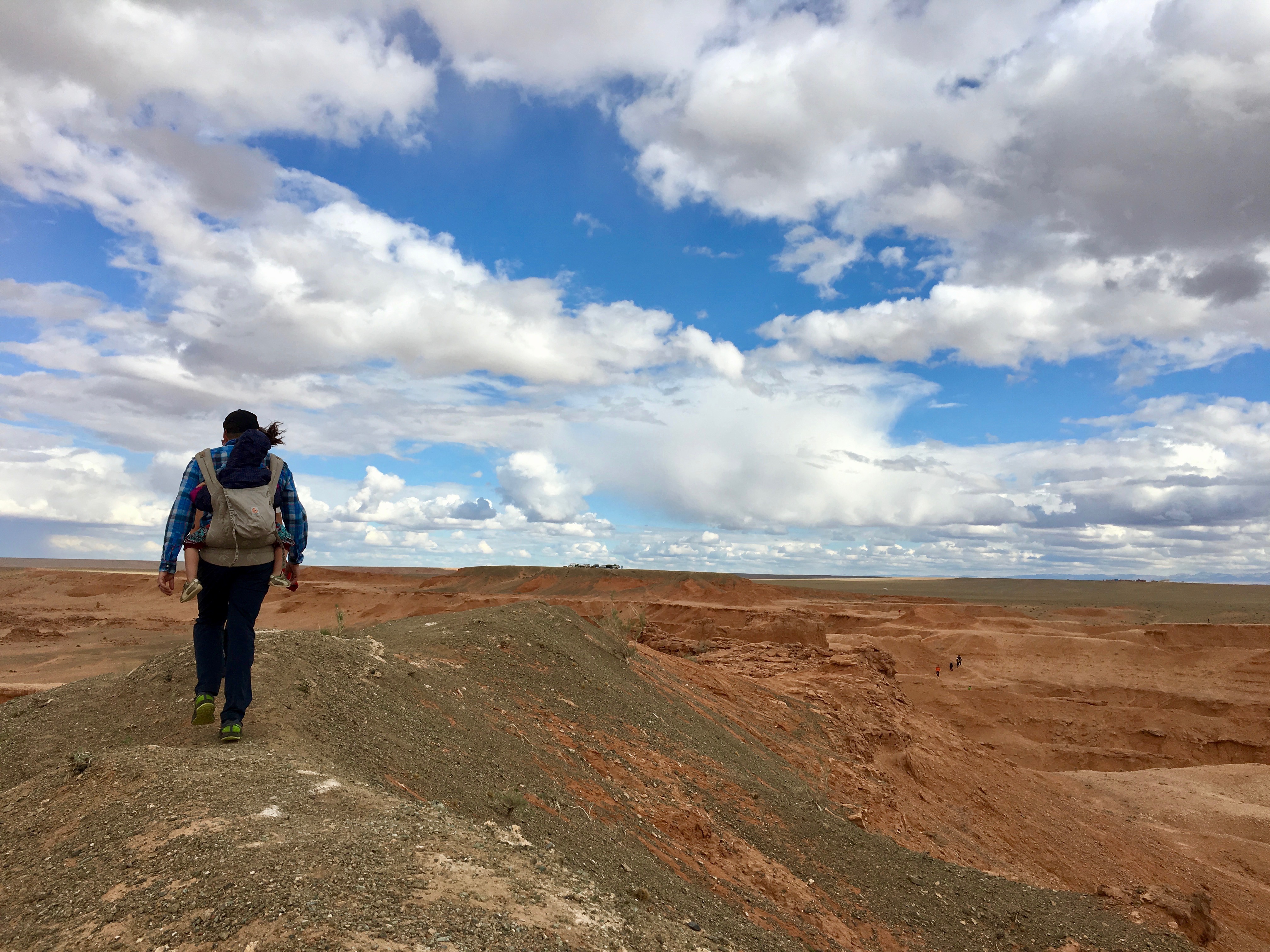
The view from the top of the Flaming Cliffs (Photo: Bre Power Eaton)
After dinner that night, the gur camp staff showed a black-and-white documentary about Andrews’ dinosaur discoveries from almost a century ago.
“We were there today,” I whispered to Emi, pointing to the small television screen. The titillating sense of adventure I’d felt while exploring the cliffs returned along with a little humor. How silly it was to think we might stumble upon a fossil.
But, really, why not? It had happened before. In fact, almost a decade ago, I had the chance to interview a paleontologist who was part of a Gobi Desert expedition that had discovered a fossilized nest filled with baby Protoceratops, with their rounded, shell-like heads. The 70-million-year-old findings led them to conclude that unlike reptiles who ditch their young, dinosaurs cared for their babies more like birds. Though he’d joked that expeditions were not Indiana Jones style adventures and more often filled with mundane, bounty-less days spent staring at sand, sand and more sand, I could not help but imagine traipsing across the Gobi Desert, searching for the remains of ancient beasts.
Today, I’d finally had my chance. The search in itself was satisfying.
A Family Secret
Knowing that a dinosaur finding was unlikely, our devoted guide, Orgi, had asked our driver, Banza, to stop on our way to the Flaming Cliffs at a tourist camp she’d visited before. Standing alone, the camp had seemed stranded, like so many camps and gurs we’d seen in the distance as our van had bobbed along the roadless desert. Unlike the circular gur tents at most camps, many of the buildings were shaped instead like dinosaurs. Their painted exteriors were chipped and faded, echoes of the harsh, fickle weather; the sky’s sudden greying, when ferocious sandstorms begin to whirl.
Orgi motioned for us to follow a young man toward a small building. Inside, we stepped down into what seemed a hastily added brick room. There, before our eyes, lay a dinosaur fossil: a long back bone, with broken ribs fanning from each side, still encased in dirt. The owners had found the fossil and wanted to protect it, so they’d brought it home.
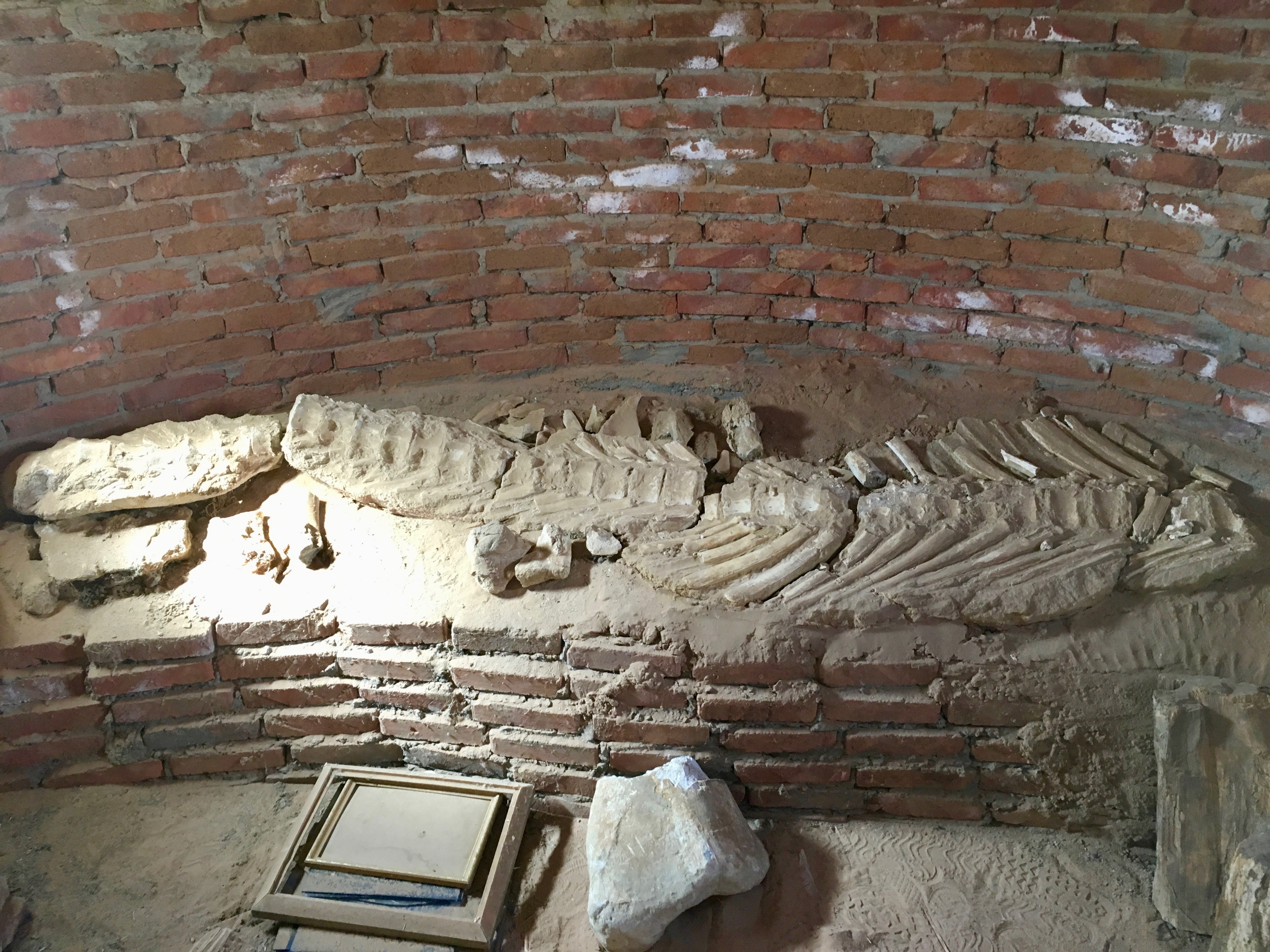
A hidden dinosaur fossil (Photo: Bre Power Eaton)
On the ground inside the main room, on a pile of rocks, lay another piece of bone. At a glance, the fossil resembled a rock, smudged with grey dirt. Orgi knelt beside it, smiling wide. Emi and I followed suit, in awe of both the fossil and the extraordinary chance to see it up close. Orgi handed me what appeared to be a joint, about the size of my head. I stared in complete wonder, as if I were holding a unicorn’s horn.
When I offered it up to Tom, he kept his hands at his sides and shook his head. I cocked mine. Really?
Later Tom would reveal that touching such rare remains had just not felt right. And I would nod. Feel a pang of guilt. Part of the allure of visiting the Flaming Cliffs is the lack of fences, glass and guards. My eyes had freely scoured the cliffsides, granule by granule; my fingers had grazed their rough surface, in search of a smooth, egg-white fragment. All the while, though, I’d tried to ignore the sting of sadness. How much longer would this natural treasure last?
Free for All
Years prior, I’d read an article in the New Yorker about Mongolia’s fight to repatriate fossils that had been illegally excavated, then taken and sold overseas. In 2013, the Mongolian government received word from a native paleontologist, Bolortsetseg Minjin, living in New York, who’d read about the auction of a Tarbosaurus bataar, a Mongolian relative of the infamous T-Rex. Though illegal, fossil scavenging is not a new occurrence. This time, however, the Mongolian government decided to do something about it and hired a lawyer to stop the sale.
Even so, against a judge’s orders, an auctioneer sold the T-bataar, posed in a fierce predatorial stance, for a million dollars. In the end, the fossil was finally returned to Mongolia. This victory led to galvanized efforts to educate Mongolians about their coveted natural treasures and their exploitation, starting with the opening of the Central Museum of Mongolian Dinosaurs in Ulaanbaatar, featuring none other than the repatriated T-bataar.
While watching the documentary that night, I’d laughed with Orgi and Banza when the expedition’s cars bumped slowly along the roadless terrain. At one point, the caravan got stuck in the mud, just like our van had. We chuckled, bonding in the hilarity of shared struggle. Still today, Banza navigates the wide-open steppe using well-worn tracks and distant landmarks when tracks disappear. Not much has changed since 1922.
How, I began to wonder, can Mongolia build the necessary infrastructure to protect its hidden treasures when it is navigating development, struggling to employ the flood of nomads-turned-city-dwellers, who’ve lost their herds to harsher and harsher winters? Could their bounty of pre-historic gems be part of the country’s path to development, attracting more adventurers’ and even locals’ attention? Such a change too would come with great cost. Goodbye fenceless exploration. Hello parking lots.
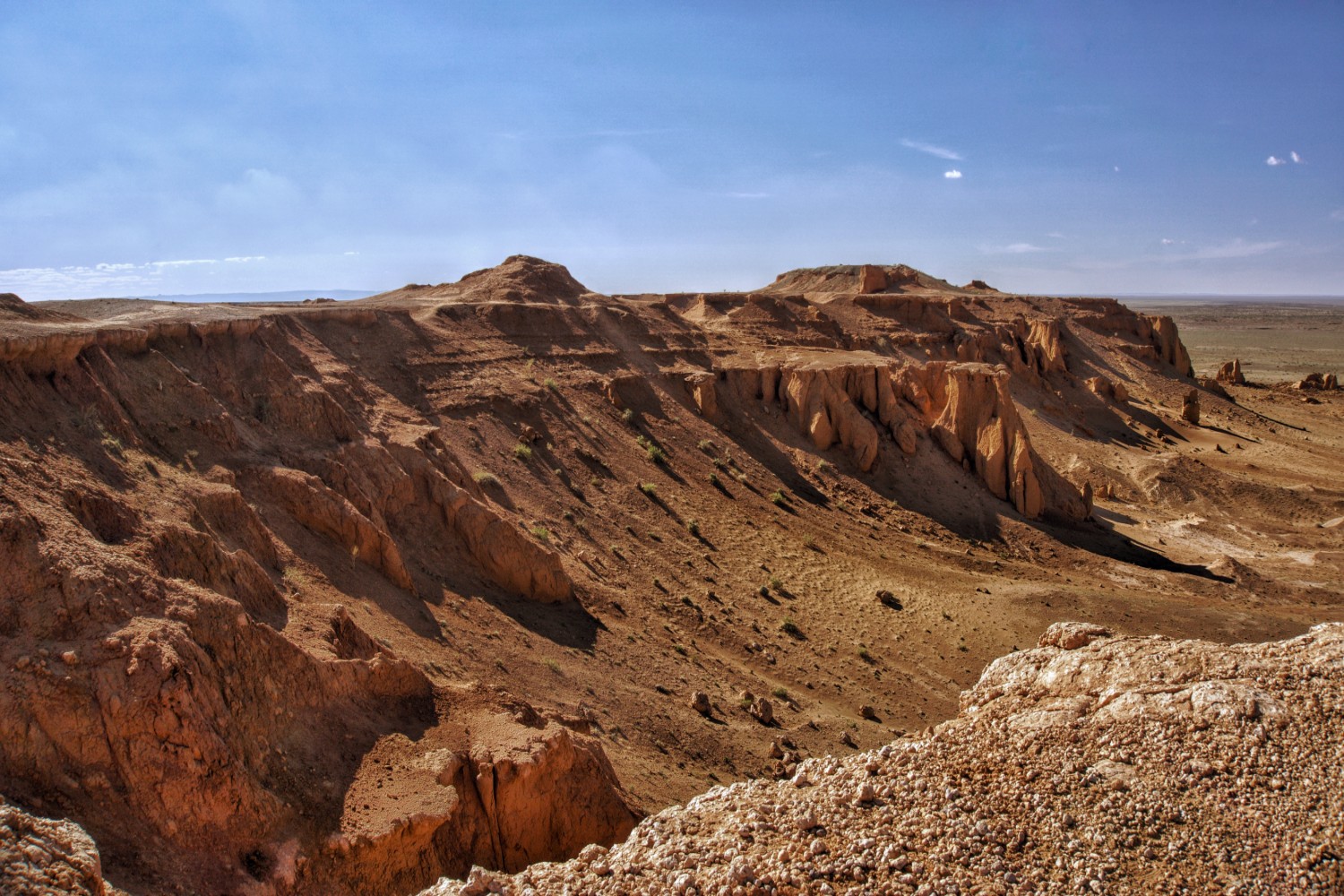
Bayanzag (Photo: Enguerran Zandonai)
Behind Closed Doors
While researching for our trip, I’d learned that the Natural History Museum had closed for renovation, but I could not find any information about where the fossils had been moved. In hopes of finding the famous fighting dinosaurs, Tom had asked our tour company to add a dinosaur museum visit to our itinerary. The museum was one of our last events, in our final hours with Orgi.
The small museum, it turned out, was at a mall. Short on time, we arrived to find the museum doors surprisingly locked. Exhausted after over a week of bobbing along the steppe, we were tempted to give up. To be satisfied by the bone I’d held and the mini-museum we had stumbled upon in a village, where we’d seen crystals growing in the hollows of fossilized dinosaur bones.
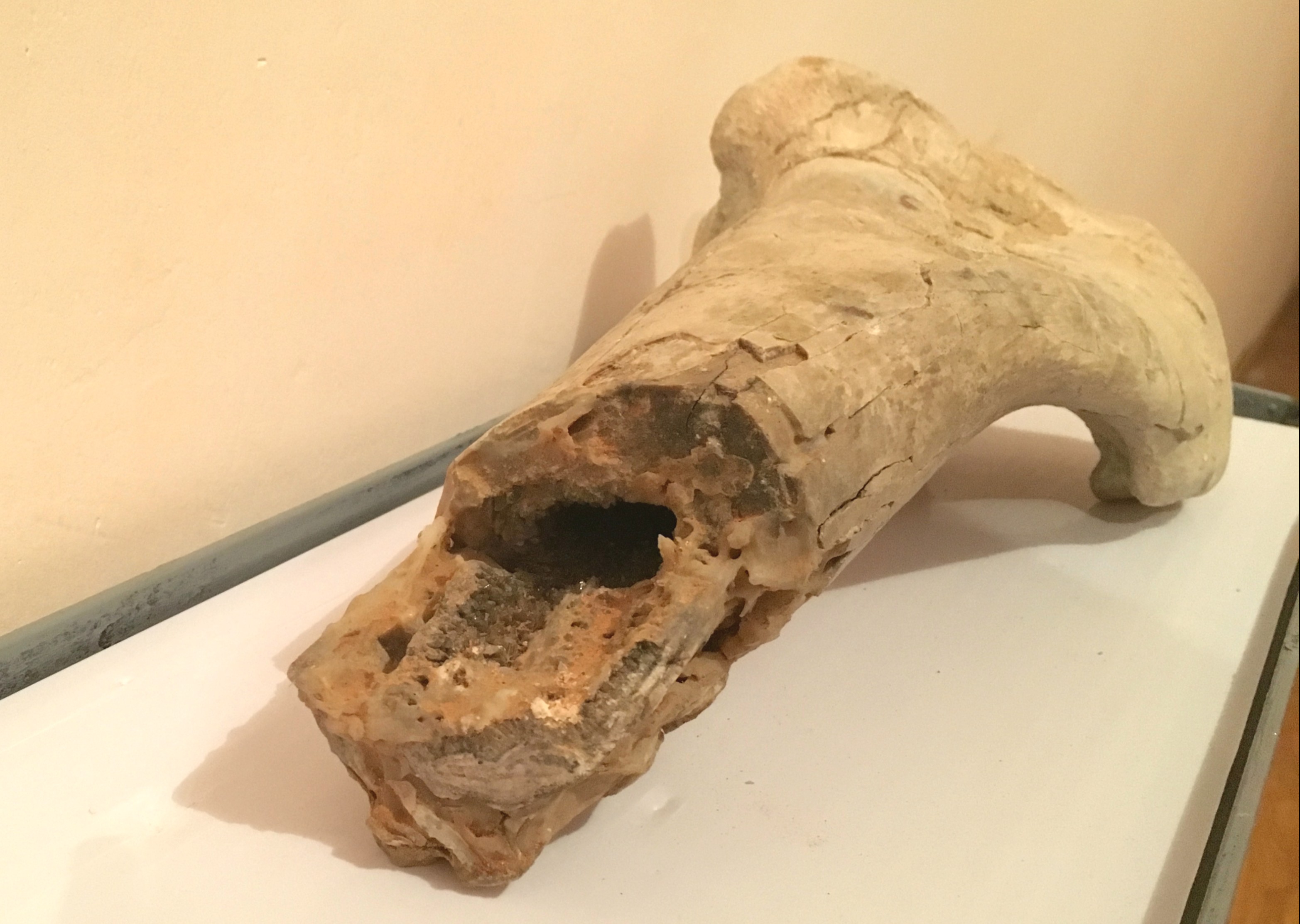
Crystals inside a fossilized dinosaur bone on display at a tiny, local museum (Photo: Bre Power Eaton)
But I remained curious. What if the fighting dinosaurs were just beyond the locked doors? I did not want to leave, forever wondering, what if?
Orgi ran off to find help.
Even though Emi had asked daily (sometimes hourly) if we were going to the dinosaur museum, she seemed more captivated by a hip-hop dance lesson that started in the open square in front of the museum. Conveniently distracted, Emi strode into the crowd of mostly teens and nodded her tiny head to the beat.
A few feet away, Tom and I watched and waited, standing beneath the intimidating jaws of a T-bataar skeleton. On the opposite side of the square, the bones of a long-necked dinosaur rose above the crowd. All eyes, though, were on the enthusiastic hip-hop dancer onstage. I’d rather Emi be dancing than bawling, but sadness swelled inside me again. Here we were, standing amongst relics of the prehistoric past as if they were mere decorations. Even Emi’s initial elation quickly faded, stolen by the bumping bass.
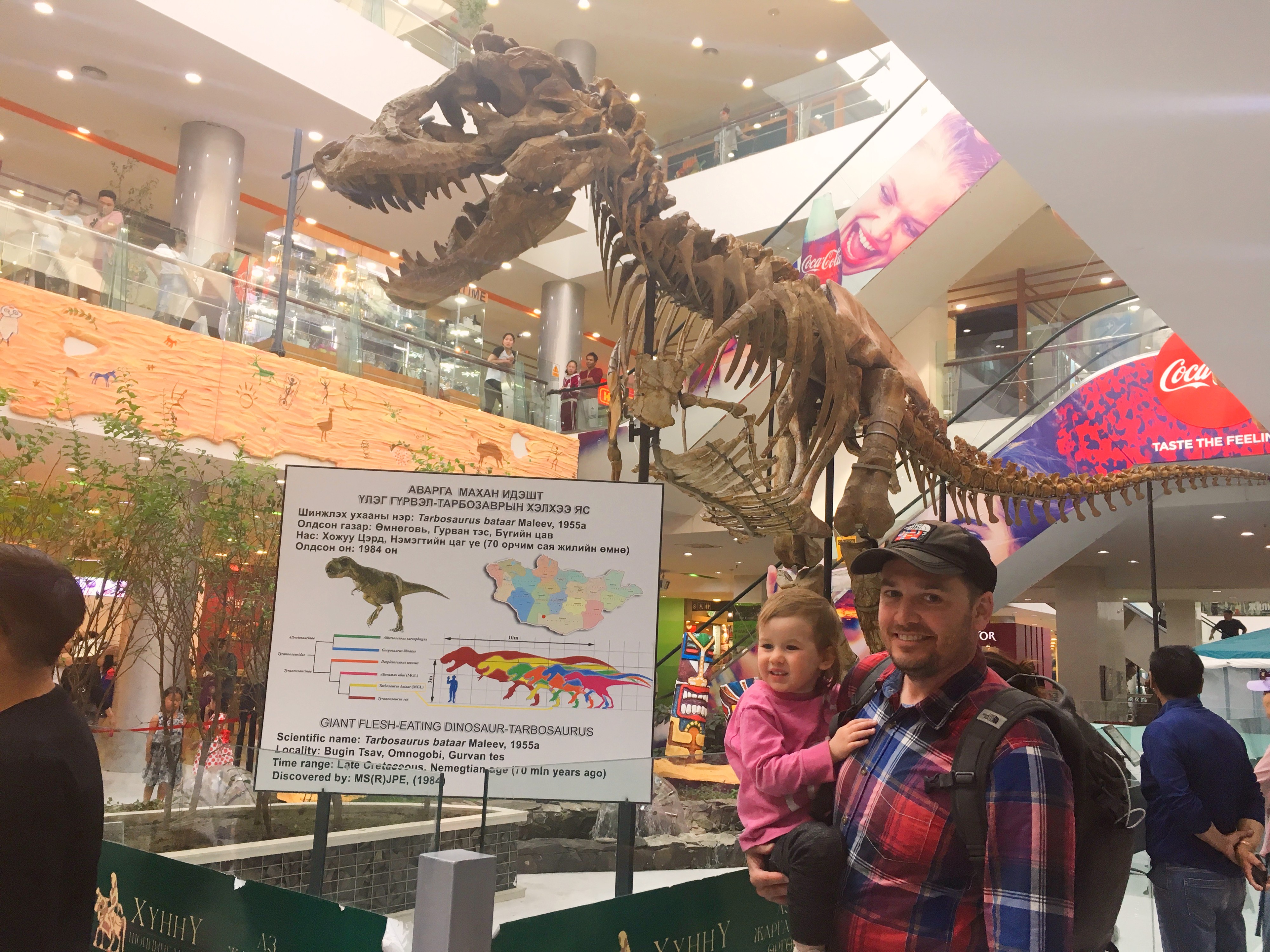
Tom and Emi stand underneath a T-bataar near the dinosaur museum at Hunnu Mall in Ulaanbaatar (Photo: Bre Power Eaton)
When the museum attendant finally appeared, apologizing, we rushed inside. The museum was dimly lit. Glass cases formed a mini-maze, revealing dinosaur fossils, from bits to parts to full-bodies in mock action.
“Fossilized eggs!” we exclaimed, guiding our giddy Emi around.
“Look at that Protoceratops head! And there, such sharp claws!”
“Did you see the armored ones?” I asked Tom, with true excitement in my eyes. “I’ve never seen fossils like these up close.”
Then, finally, there they were. The fighting dinosaurs. Or what I assumed to be THE fighting dinosaurs. The fossil appeared to be of two dinosaur skeletons clashing, but it was smaller than I’d anticipated, able to be entombed in a rectangle of glass. Even so, holding Emi up to see, I was spell-bound. Before us was a pre-historic freeze frame, a rare glimpse of the harshness of dinosaurs’ every day. For Emi, I hoped, it was a glimpse of books coming to life.
Special thanks to Horseback Mongolia for their flexibility, hospitality and expertise. Note: This story was based upon Bre Power Eaton’s personal travels. She did not receive comps for this story.